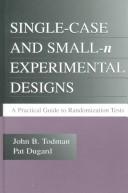| Listing 1 - 2 of 2 |
Sort by
|
Book
ISBN: 9780415886932 9780415886222 9780203180938 9781136588433 9781136588471 9781136588488 Year: 2012 Publisher: London Routledge
Abstract | Keywords | Export | Availability | Bookmark
 Loading...
Loading...Choose an application
- Reference Manager
- EndNote
- RefWorks (Direct export to RefWorks)
This practical guide explains the use of randomization tests and provides example designs and macros for implementation in IBM SPSS and Excel. It reviews the theory and practice of single-case and small-n designs so readers can draw valid causal inferences from small-scale clinical studies. The macros and example data are provided on the book's website so that users can run analyses of the text data as well as data from their own studies. The new edition features: More explanation as to why randomization tests are useful and how to apply them. More varied and expanded examples that demonstrate the use of these tests in education, clinical work and psychology. A website with the macros and datasets for all of the text examples in IBM SPSS and Excel. Exercises at the end of most chapters that help readers test their understanding of the material. A new glossary that defines the key words that appear in italics when they are first introduced. A new appendix that reviews the basic skills needed to do randomization tests. New appendices that provide annotated SPSS and Excel macros to help readers write their own or tinker with the ones provided in the book. The book opens with an overview of single case and small n designs -- why they are needed and how they differ from descriptive case studies. Chapter 2 focuses on the basic concepts of randoization tests. Next how to choose and implement a randomization design is reviewed including material on how to perform the randomizations, how to select the number of observations, and how to record the data. Chapter 5 focuses on how to analyze the data including how to use the macros and understand the results. Chapter 6 shows how randomization tests fit into the body of statistical inference. Chapter 7 discusses size and power. The book concludes with a demonstration of how to edit or modify the macros or use parts of them to write your own. Ideal as a text for courses on single-case, small n design, and/or randomization tests taught at the graduate level in psychology (especially clinical, counseling, educational, and school), education, human development, nursing, and other social and health sciences, this inexpensive book also serves as a supplement in statistics or research methods courses. Practitioners and researchers with an applied clinical focus also appreciate this book's accessible approach. An introduction to basic statistics, SPSS, and Excel is assumed.
Statistical hypothesis testing. --- Experimental design. --- PSYCHOLOGY / Research & Methodology. --- EDUCATION / Experimental Methods. --- MEDICAL / Nursing / Research & Theory. --- Statistiek (theorie) --- Tests (geneeskunde) --- Experimental design --- Statistical hypothesis testing --- Hypothesis testing (Statistics) --- Significance testing (Statistics) --- Statistical significance testing --- Testing statistical hypotheses --- Distribution (Probability theory) --- Hypothesis --- Mathematical statistics --- Design of experiments --- Statistical design --- Mathematical optimization --- Research --- Science --- Statistical decision --- Statistics --- Analysis of means --- Analysis of variance --- Experiments --- Methodology --- Test (geneeskunde)

ISBN: 0805835547 Year: 2001 Publisher: Mahwah (N.J.) Lawrence Erlbaum
Abstract | Keywords | Export | Availability | Bookmark
 Loading...
Loading...Choose an application
- Reference Manager
- EndNote
- RefWorks (Direct export to RefWorks)
This book is a practical guide to help researchers draw valid causal inferences from small-scale clinical intervention studies. It should be of interest to teachers of, and students in, courses with an experimental clinical component, as well as clinical researchers. Inferential statistics used in the analysis of group data are frequently invalid for use with data from single-case experimental designs. Even non-parametric rank tests provide, at best, approximate solutions for only some single-case (and small-'n' ) designs. Randomization (Exact) tests, on the other hand, can provide valid statistical analyses for all designs that incorporate a random procedure for assigning treatments to subjects or observation periods, including single-case designs. These Randomization tests require large numbers of data rearrangements and have been seldom used, partly because desktop computers have only recently become powerful enough to complete the analyses in a reasonable time. Now that the necessary computational power is available, they continue to be under-used because they receive scant attention in standard statistical texts for behavioral researchers and because available programs for running the analyses are relatively inaccessible to researchers with limited statistical or computing interest. This book is first and foremost a practical guide, although it also presents the theoretical basis for Randomization tests. Its most important aim is to make these tests accessible to researchers for a wide range of designs. It does this by providing programs on CD-ROM that allow users to run analyses of their data within a standard package (Minitab, Excel, or SPSS) with which they are already familiar. No statistical or computing expertise is required to use these programs. This is the "new stats" for single-case and small-'n' intervention studies, and anyone interested in this research approach will benefit.
Experimental design. --- Statistical hypothesis testing. --- Experimental design --- Statistical hypothesis testing --- Hypothesis testing (Statistics) --- Significance testing (Statistics) --- Statistical significance testing --- Testing statistical hypotheses --- Distribution (Probability theory) --- Hypothesis --- Mathematical statistics --- Design of experiments --- Statistical design --- Mathematical optimization --- Research --- Science --- Statistical decision --- Statistics --- Analysis of means --- Analysis of variance --- Experiments --- Methodology --- Statistiek (theorie) --- Tests (geneeskunde) --- Test (geneeskunde)
| Listing 1 - 2 of 2 |
Sort by
|

 Search
Search Feedback
Feedback About UniCat
About UniCat  Help
Help News
News